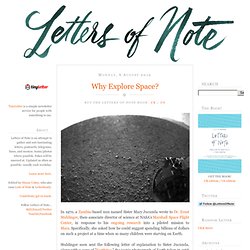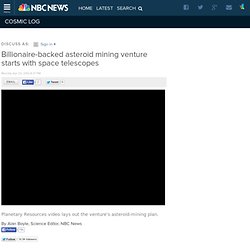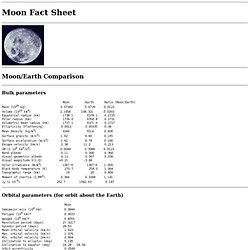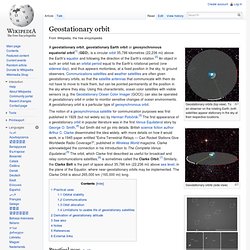

Neil deGrasse Tyson - We Stopped Dreaming (Episode 1) We Stopped Dreaming (Episode 2) - A New Perspective. Why Explore Space? .

Specifically, she asked how he could suggest spending billions of dollars on such a project at a time when so many children were starving on Earth. Stuhlinger soon sent the following letter of explanation to Sister Jucunda, along with a copy of "Earthrise," the iconic photograph of Earth taken in 1968 by astronaut William Anders, from the Moon (also embedded in the transcript). His thoughtful reply was later published by NASA, and titled, "Why Explore Space? " May 6, 1970Dear Sister Mary Jucunda:Your letter was one of many which are reaching me every day, but it has touched me more deeply than all the others because it came so much from the depths of a searching mind and a compassionate heart. The photograph which I enclose with this letter shows a view of our Earth as seen from Apollo 8 when it orbited the moon at Christmas, 1968. Garvey Spacecraft Corporation - Home Page. Helium 3 for Fusion. Billionaire-backed asteroid mining venture starts with space telescopes.
Planetary Resources video lays out the venture's asteroid-mining plan.

By Alan Boyle, Science Editor, NBC News The venture known as Planetary Resources eventually plans to go asteroid mining — but the first step in the billionaire-backed business plan is to launch an orbital fleet of "personal space telescopes" capable of looking out into the heavens or back down on Earth. Right now, the idea of sending robotic drilling operations to near-Earth asteroids, extracting water for powering interplanetary spaceships — and, by the way, turning that into a profitable business — sounds like pure science fiction. But to quote Planetary Resources' president and chief engineer, Chris Lewicki: "Everything is science fiction right up to the point that it's science fact.
" Lewicki knows his way around an outer-space challenge. Diamandis said Planetary Resources follows up on discussions that he and Anderson had starting about three years ago — and also follows up on a nearly lifelong ambition he's had. Planetary Fact Sheet - U.S. Units. Moon Fact Sheet. Bulk parameters.

Basics of Space Flight: Orbital Mechanics. Orbital mechanics, also called flight mechanics, is the study of the motions of artificial satellites and space vehicles moving under the influence of forces such as gravity, atmospheric drag, thrust, etc.

Orbital mechanics is a modern offshoot of celestial mechanics which is the study of the motions of natural celestial bodies such as the moon and planets. The root of orbital mechanics can be traced back to the 17th century when mathematician Isaac Newton (1642-1727) put forward his laws of motion and formulated his law of universal gravitation. The engineering applications of orbital mechanics include ascent trajectories, reentry and landing, rendezvous computations, and lunar and interplanetary trajectories. Conic Sections A conic section, or just conic, is a curve formed by passing a plane through a right circular cone. We can define all conic sections in terms of the eccentricity. Satellite orbits can be any of the four conic sections. Lagrange Points of the Earth-Moon System. A mechanical system with three objects, say the Earth, Moon and Sun, constitutes a three-body problem.
The three-body problem is famous in both mathematics and physics circles, and mathematicians in the 1950s finally managed an elegant proof that it is impossible to solve. However, approximate solutions can be very useful, particularly when the masses of the three objects differ greatly. For the Sun-Earth-Moon system, the Sun's mass is so dominant that it can be treated as a fixed object and the Earth-Moon system treated as a two-body system from the point of view of a reference frame orbiting the Sun with that system. 18th century mathematicians Leonhard Euler and Joseph-Louis Lagrange discovered that there were five special points in this rotating reference frame where a gravitational equilibrium could be maintained. That is, an object placed at any one of these five points in the rotating frame would stay there, with the effective forces with respect to this frame canceling.
Geostationary orbit. Geostationary orbits (top view).

To an observer on the rotating Earth, both satellites appear stationary in the sky at their respective locations. Geostationary orbits (side view) A 5 × 6 degree view of a part of the geostationary belt, showing several geostationary satellites. Those with inclination 0 degrees form a diagonal belt across the image; a few objects with small inclinations to the Equator are visible above this line. The satellites are pinpoint, while stars have created small trails due to the Earth's rotation. A geostationary orbit, geostationary Earth orbit or geosynchronous equatorial orbit[1] (GEO), is a circular orbit 35,786 kilometres (22,236 mi) above the Earth's equator and following the direction of the Earth's rotation.[2] An object in such an orbit has an orbital period equal to the Earth's rotational period (one sidereal day), and thus appears motionless, at a fixed position in the sky, to ground observers.
Practical uses[edit] Orbital stability[edit] NASA - Home. Portal. Japan Aerospace Exploration Agency.